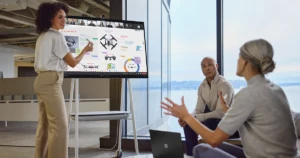
How WE embraces digital transformation to empower social good
| Focus on: Empower Employees, Optimize Operations, Engage Customers |
“Our goal is to change the world through everyday actions.”
Most pre-teens are focused on friends, sports, and school. But for 12-year-old activist Craig Kielburger, those pursuits weren’t enough. After reading the story of a child laborer who lost his life for speaking out, he started the nonprofit “Free the Children” in the late 1990s. Founded on the concept that students can take actions to change the world, his small organization quickly became a global movement inspiring millions of kids, and Craig himself became a vocal advocate for youth empowerment, featured on programs such as 60 Minutes.
Now named WE, the organization is dedicated to changing the world one person at a time. It provides youth across the globe with the inspiration, information, and tools to do just that.
Today, WE is 1,200 employees strong across Canada, the United States, and the United Kingdom. Much of its growth can be attributed to its dedicated employees, including Erin Barton and Dan Kuzmicki. Erin Barton was a WE youth member when, in 2000, she became the first full-time, year-round employee hired by the nonprofit. Five years later, fresh out of college, Dan Kuzmicki joined WE as a database administrator. “Back then we had 20 people in a single building,” Dan says. Today, he serves as Director of IT and Enterprise Services, while Erin’s role as Chief Development Officer puts her in charge of partnerships globally. Both Dan and Erin have seen many growing pains and technology transitions along the way. “WE was the equivalent of a startup when I started,” remembers Dan. “It was a small group of passionate individuals looking to make a difference in the world.”

WE has grown and evolved substantially since its launch as a nonprofit and social enterprise. Fundamentally, the organization empowers youth to support whatever cause they are most passionate about – whether that be bullying, hunger, homelessness, accessibility, literacy – or countless other causes that motivate youth to take action. It runs three main programs that work together to maximize its global impact: WE Villages, WE Schools, and WE Days. Me to WE—the nonprofit’s social enterprise arm—helps support these programs while giving the organization a way to offset operating costs and reinvest in its growth.
WE Villages leads international projects to empower underserved communities by focusing on five transformative pillars: education, water, health, food, and opportunity. WE Schools is a domestic education program that serves more than 12,000 schools and 3.4 million students across Canada, the US, and the UK. Youth active in WE Schools can earn tickets to celebrate their service work at WE Days—stadium-sized events where motivational speakers, social entrepreneurs, bands, celebrities, and thought leaders inspire the approximately 15,000 attendees per event—primarily youth—to make a difference through local and global action.

Laying a new foundation “To be able to grow and scale without adding more staff and resources, we needed to invest in technology and rethink how we delivered programs, utilized resources, and handled outreach,” says Erin.
It took WE 20 years to grow to 12,000 schools. Their goal today is to more than double that number in the next five years. Both Dan and Erin agree that technology is the best way to get there.
“We found ourselves at a crossroads,” Erin explains. As the nonprofit consolidates into one “mega space,” it’s investing a great deal in the technology and infrastructure that will allow the team to scale and reach a global community. “What we did for the last 20 years as an organization isn’t what we need to be doing the next 20 years. So we’re laying a new foundation,” Dan explains. “And technology is a primary driver.”
But there are barriers to achieving their aspirations, not the least of which is a disconnected patchwork of infrastructure. “Our tools and platforms are siloed,” says Dan. Traditional processes are holding the nonprofit back from collaborating internally, communicating externally, and staying true to a customer-centric approach.
“We are still using a lot of manual processes to keep teams updated internally and track information, and we want to have stronger documentation and standardization,” Erin explains. The right CRM system is critical. Erin must be able to quickly and efficiently track partner commitments and financials. “When we look at the metrics, we need to ask ourselves: What tools could we be using? What analytics could we could be pulling from Power BI to inform our strategies?” she explains. The goal is for WE to become increasingly professional in the way it works with partners. “What we are trying to achieve is ultimately a global and interconnected movement,” Erin explains. “That requires us to tap into technology.”
To that end, WE hired a Chief Technology Officer to lead their digital transformation and looked for a technology partner that could help them become a smarter, digital-first organization. They considered the top technology companies they believed could help them achieve their goals.
When they asked which partner could help them migrate to the cloud, which had the underlying technology to help them transition, and which had a team of experts that could provide assistance along the way, “Partnering with Microsoft was a no brainer,” Dan says. “We’re at the beginning of what I think is a fantastic journey of digital transformation.”
This spring, WE attended a Microsoft Design Experience workshop to help the organization envision their digital transformation and what it could mean for their stakeholders. Take a peek inside their two-day workshop.
Optimizing operations in the cloud From the service desk to the DevOps, web, and analytics teams, WE is driving toward becoming a smarter organization, leveraging technology and metrics, and moving everything to a single, unified cloud platform. “Azure has been a game changer for us,” says Dan. Not only are tasks such as onboarding much faster, but the operations team is transitioning to a highly agile DevOps model. Part of a strategic grant from Microsoft Philanthropies, Azure is a key driver for this change, offering more predictable delivery, reliability, and scalability.
When WE started, groups were meeting in person. The organization was geographically limited and made similarly limited use of technology. “Everyone had to make their way to Toronto,” Erin says. “We learned quickly that if we wanted to grow, we would need to find ways for people to participate in the movement that wouldn’t require them to come to one location.”
WE transitioned from a “come to us” to a “we’ll come to you” model. But even these leadership workshops, held onsite in various locations still required face-to-face contact. Team members were still required to travel to facilitate the experience and resources still had to be printed and shipped. “We are a nonprofit with a small budget,” explains Erin. “At one point, we were printing on paper and then had to hole punch by hand to save a little money.”

Today, WE has a world-class website and social media presence and is working on next-level improvements in the ways people can engage with the nonprofit such as mobile applications and video-based content. “Our production and hosting capacities are somewhat limited by our technology,” Erin says. Microsoft tools such as Skype and Skype for Business are changing that.
The organization was forced to take a hard look at what it would take for WE to scale globally. OneNote and SharePoint will reduce printing and shipping costs. Lesson plans can now be hosted online and are available in OneNote so they are more interactive for educators. WE plans to increasingly deliver professional development online.
Empowering employees to have a greater impact Because WE is both a nonprofit and a social enterprise, it is a complex organization. The teams responsible for their two offerings were operating in separate silos. These disparate systems didn’t communicate well with each other and led to challenges in visibility and reporting. Replacing several different solutions and platforms with one universal platform for file storage and data management has streamlined processes.
With more than 200 partnerships and millions of stakeholders, just staying on point with the latest version of each document is a serious challenge. As the organization grows, more pain points are becoming evident. Erin has seven different logins for every system from expense reporting to HR, and multiple platforms and processes made onboarding painful. Each silo used different solutions making everything from inventory and logistics to finance and P&Ls cumbersome. Transitioning to Dynamics 365 allows the team to host its CRM and ERP on the same cloud, giving them a much more holistic view of their data and the ability to deep dive into each team to see what’s happening.
SharePoint and OneDrive are helping the organization convert manual processes to digital and improve internal collaboration. Single Sign On will save WE an entire hire by consolidating how they automate and access systems like CRM and HR. “It allows us to maintain scale and speed without adding resources and the staff to support those things,” Dan says. WE is working on hosting all of its systems and applications on Azure.
WE’s staff is lean compared to other organizations like it that have a staff three times larger. Eight web developers are responsible for all solutions from WE’s main web site to the donation pages and campaign registration pages. “We have no plans to increase staffing exponentially,” says Dan. “Our investments are mainly around training, creating an agile model, and relying on metrics to drive our areas of focus.”
Breaking down geographic barriers and enabling greater reach Digitizing WE is a must if the nonprofit hopes to achieve its growth and reach goals. WE’s partners invest in the organization because they believe in the power of what the nonprofit does. “They’re eager to see us scale,” Erin says. In order to deliver the most value and get the most value from its partners, WE has to think and act like a smart business. That means using technology to its fullest.
One example is the transformation of the WE Schools program. Traditionally, WE printed and boxed individual kits and mailed them out to schools. Now, OneNote is digitizing publication of WE Schools resources and enabling easier, more cost-effective distribution around the globe. The team has begun using video-based communication, and Skype for Business is transforming engagement with stakeholders across touch points.

“We are very hands-on,” says Erin. “Technology lets us deliver high quality stakeholder experiences without incurring a lot of the additional costs.” Also in the works is a new Skype-enabled learning center that will allow the team to reach stakeholders in new and modern ways.
Another WE ambition is to create a digital experience to accompany and extend the broadcast WE Day events, packaging content so that it can live on all year long. Because the majority of WE’s partners have some engagement with WE Day, it needs to be an event experience that is more accessible to a diverse audience.
“We’re attempting to share our message more broadly,” Erin says. That means offering the highest quality real-time feeds with a global look and feel. “We’re learning from the Microsoft events and studios teams.”
Microsoft Philanthropies played a key role in bringing WE Day to the U.S. for the first time in 2013, sponsoring events in California and Seattle. Microsoft North America added their support in 2016, helping expand the reach of WE Day to include Chicago and New York. Catch a glimpse of WE Day.
Driving digital transformation for social good “Digital transformation is a big fancy phrase,” Erin says. “But it’s challenging us to think about who our users are, what the experience is that we are looking to create, and how technology can support that and even lead the way.” Moving forward, technology will play an integral role in allowing WE to empower even more young people and foster a global, interconnected movement. “Cutting edge technology allows us to be more effective and reach a global audience,” says Erin. “And a bigger audience equals more lives changed.”
To other companies thinking about their own digital transformation, Dan advises, “Stop thinking about it and start the journey.” In the nonprofit sector especially, he has seen organizations spend two years or more thinking about whether they should migrate to the cloud or upgrade CRM solutions, for example. “It’s painful to watch,” he says. “My advice? Start the journey as quickly as possible.” The horizon of technology is changing so fast. Companies must adapt and pivot quickly, changing their business models in order to do so.
With the help of a Microsoft, WE has its sights set on achieving more. Dan concludes, “We are truly thinking differently about what’s possible.”
Related Content
- Find out more about how major tech upgrades help WE empower more young people to change the world
- Empower your organization to succeed in the digital era with Microsoft Digital Advisory Services
- Explore more Real Stories of Digital Transformation





